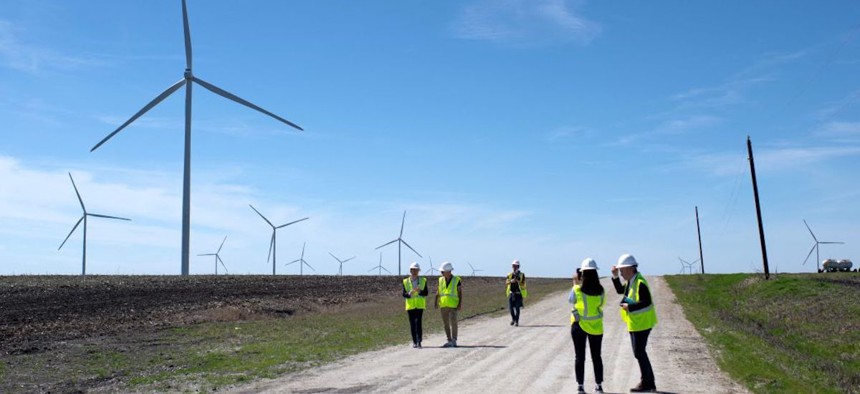Feds announce funds for renewable energy facility planning

Employees of the utility company Engie walk down a road for a closer look at wind turbines during a tour of the Limestone Wind Project in Dawson, Texas, on February 28, 2023. Photo by MARK FELIX/AFP /AFP via Getty Images
State and local governments can apply for funds to support the complex decision-making processes around large-scale renewable energy planning, siting and permitting.
The nation needs more renewable energy sources to reach President Joe Biden’s goals of achieving a 100% clean electricity sector and net-zero emissions economy by 2050, but planning and building wind, solar or geothermal utilities is a complex task few communities have tackled. To smooth the process, the U.S. Energy Department is set to help fund state planning efforts.
The funding from the Renewable Energy Siting Through Technical Engagement and Planning program, or R-STEP, will help state-based collaboratives conduct the extensive and complex planning, siting and permitting required for large-scale renewable energy facilities. For instance, funds can go toward hiring and training a workforce in the skills essential for determining the best places to build renewable energy plants or toward developing state-specific resources to conduct compliance reviews or negotiate grid interconnection agreements.
To make it easier for future renewable energy innovation, R-STEP will support information sharing and collaboration among states, according to the Office of Energy Efficiency and Renewable Energy, or EERE.
“Where and how large-scale solar, wind and other renewable energy facilities are sited matters to communities,” EERE’s Acting Assistant Secretary Alejandro Moreno said in an Aug. 1 statement announcing the program. “State and local authorities have important roles in evaluating and proactively planning for clean energy opportunities, but they may not have the resources to carefully consider many complex issues and perspectives.”
For example, deciding where to build a renewable energy facility can be a cross-governmental and cross-departmental endeavor as various stakeholders tackle decisions regarding permitting requirements, community priorities, resource and transmission availability, and environmental impacts. The decision-making can be further complicated when zoning and permitting authorities differ among state and local governments. Some states reserve the power to approve construction of energy facilities, for instance, while other states may yield authority to local governments.
Developers also face a slew of steps before they break ground, such as conducting studies and obtaining the appropriate permits covering construction aspects ranging from impacts on stormwater systems, surrounding wildlife or cultural and historical considerations.
Plus, officials must consider how their residents feel about renewable energy projects that could disrupt local infrastructure or landscapes. Even though a new energy facility may seem like a valid idea on paper, officials may learn at the next town hall meeting that residents have qualms about it.
In fact, a May report from Columbia Law School highlighted ongoing opposition to renewable energy projects from local communities, such as residents who disapprove of noisy wind turbines that stick out from the normal environment as industrial eye sores. To address similar concerns, one Nebraska county earlier this year approved an ordinance that requires wind turbines to be built “[three miles] from the nearest property lines and [five] miles from any village or city,” according to the report. Other jurisdictions take a more direct approach. The Ohio Power Siting Board, the report stated, has outright rejected three solar energy project applications since last October because of community opposition.
The program will fund engagement with local governments and disadvantaged communities through efforts such as surveys and forums to identify renewable energy siting and planning priorities. These will provide feedback so officials can better manage projects with residents’ comments in mind. R-STEP also can foster technical assistance and peer-learning opportunities for officials to identify and develop solutions to community concerns, an Energy Department spokesperson told Route Fifty in an email.
Five to seven collaboratives will be awarded $1 million to $2 million each, according to the announcement. The program will be managed by the Energy Department in partnership with Energywerx, an innovation hub that supports the development of energy technology and solutions from partnerships between the Energy Department and localities, utilities and industry organizations.
The Energy Department and Energywerx will host a webinar Sept. 11 to provide further information about the program. Applications for R-STEP open Sept. 12 and are due Nov. 3.






